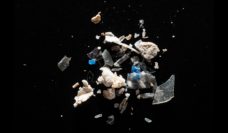Each year around 400 million tonnes of plastic are manufactured globally. Plastic is a cheap, versatile, and durable polymer commonly made from fossil fuel. It is so durable that almost 80% of all plastic waste generated since 1950–over 6000 million tonnes–remains somewhere on the planet today in marine, freshwater and terrestrial ecosystems or in landfill.
Barely a day goes by without new publications on the risks posed by this plastic waste. Early papers focussed on plastic litter in marine and coastal habitats. Recently, articles have targeted microplastics–particles and fibers less than 5 mm in size. Some arise from breakdown of larger plastic waste and some, such as microbeads in personal hygiene products or fibers released from vehicle tires or clothing, enter the environment already in this size class.
Of growing concern are plastic microfibers shed from synthetic clothing. Many are small enough to pass through the filters of washing machines and wastewater treatment plants. An estimated 0.19 million tonnes of textile microfibers are added to marine habitats alone each year. Even microplastics trapped by wastewater treatment plants may reach the environment in sludge applied to agricultural land as a fertiliser. Microfibers released from textiles also contaminate the air, particularly indoors.
For the textile industry, we propose options that include reducing consumption in total, changing laundry practices to decrease release of synthetic fibers, and increasing the share of natural biodegradable fibers. These actions are possible now.
Impacts of these microplastics on ecosystem and human health remain uncertain. There is evidence that, in aquatic habitats, organisms ingest microplastics, mistaking them for food. This can cause false satiation, low energy and even death by starvation. Microplastics can also pass up the food chain. They are found in the gut of organisms from plankton to vertebrates, including some used as human food. Further threats come from ‘hitchhikers’ on the surface of microplastics. These hitchhikers may include harmful chemicals, such as organic pollutants linked to cancer and microbial pathogens including bacteria that cause gastroenteritis and wound infections in humans.
The United Nations has described marine plastic debris as a major emerging environmental threat. Knowledge gaps remain, but delaying action until we have complete confidence in data and information is a real risk.
Our study focussed on microfibers from synthetic textiles–the polyester, acrylic and nylon clothing that fill our wardrobes in this era of fast fashion–and asked whether it was yet possible to define an indicator to guide early action to reduce future harm. The apparel and textile industry is developing tools to monitor sustainability and inform consumer choices. We concluded that microplastic pollution should be added to the list of effects counted in these tools, and that the number or mass of fibers released per unit mass of textile could provide an achievable first measure. We recommended priorities for research that would enable development of a more refined indicator, inform practical ways to minimise microfiber release and better understand the environmental and human health threats.
Risks to human health may result from exposure via multiple pathways–ingestion via food and drinking water, and through inhalation. The thought of eating and breathing plastic is alarming, but do microplastics simply pass through the body without ill effects? Can nanoplastics (particles or fibers less than 100 nm) cross cell membranes or accumulate in tissues? Do microplastics increase exposure to chemicals and pathogens? Many questions remain but the precautionary principle dictates that exposure should be monitored and reduced where possible.
There is no simple solution to eliminating the risks of microplastic waste. All actors in each segment of the complex plastic supply chain need to share responsibility. For the textile industry, we propose options that include reducing consumption in total, changing laundry practices to decrease release of synthetic fibers, and increasing the share of natural biodegradable fibers. These actions are possible now.
Photo by Alexander Andrews on Unsplash
















